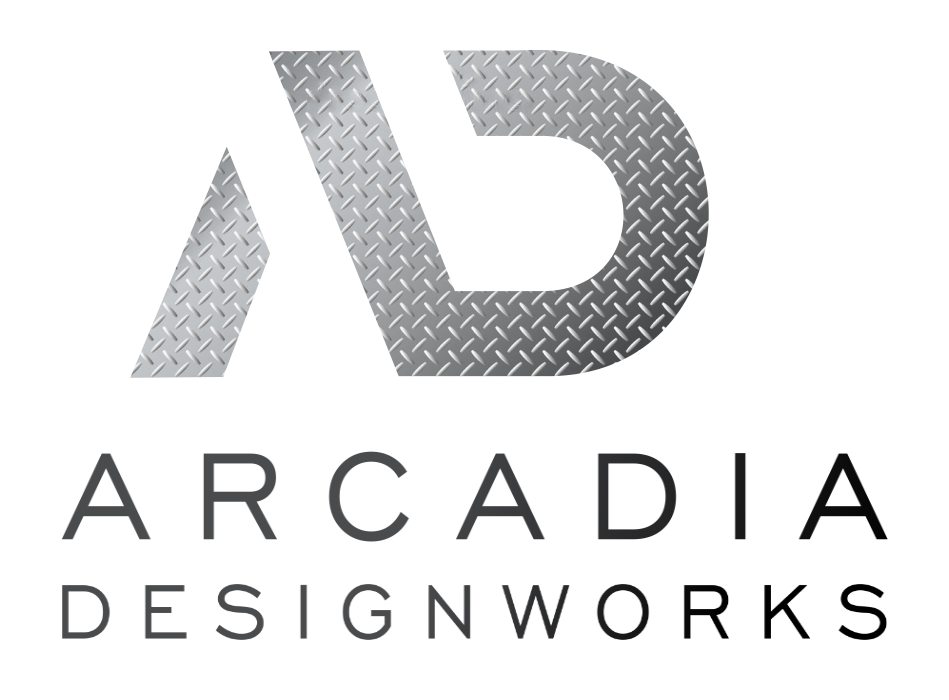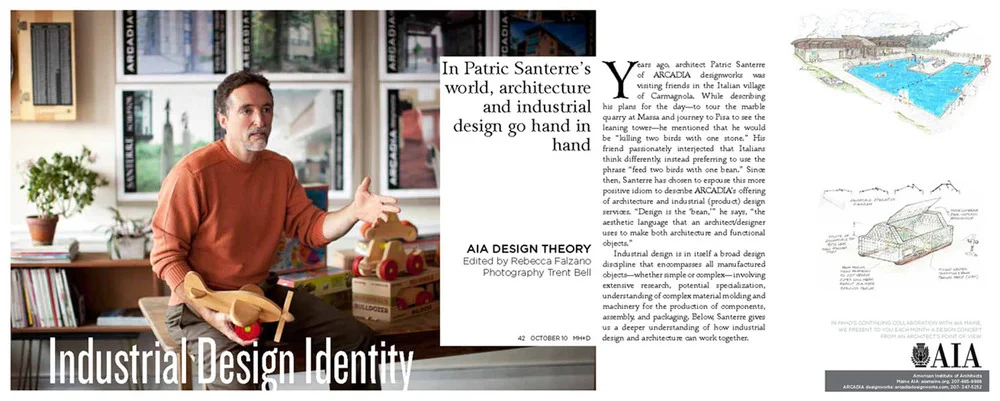ARCADIA Press
Maine Home + Design
Industrial Design Identity - AIA DESIGN THEORY
In Patric Santerre's World, Architecture and Industrial Design
October 2010
Patric Santerre (right), architect and industrial designer at ARCADIA designworks, and intern Anya Timchenko prepare data so a MakerGear M2 printer can create a window lock mechanism.
Years ago, architect and industrial designer Patric Santerre of ARCADIA designworks was visiting friends in the Italian village of Carmagnola. While describing his plans for the day—to tour the marble quarry at Massa and journey to Pisa to see the leaning tower—he mentioned that he would be “killing two birds with one stone.” His friend passionately interjected that Italians think differently, instead preferring to use the phrase “feed two birds with one bean.”
Since then, Santerre has chosen to espouse this more positive idiom to describe ARCADIA’s offering of architecture and industrial (product) design services. “Design is the ‘bean,’” he says, “the aesthetic language that an architect/designer uses to make both architecture and functional objects.”
Industrial design is in itself a broad design discipline that encompasses all manufactured objects—whether simple or complex—and involves extensive research, potential specialization, understanding of complex material molding, and machinery for the production of components, assembly, and packaging. Here, Santerre gives us a deeper understanding of how industrial design and architecture can work together.
Q: Why aren’t more architects doing industrial design?
A: In short, I would say opportunity and interest. Although Maine is still manufacturing a variety of raw materials and specialty items, the production of consumer-type goods is limited. Therefore, designers are in less demand. Also, many companies with engineers on staff do not fully understand the value that an industrial designer can bring to a product. However, architects have been designing manufactured products since the early 1900s. Peter Behrens, one of the first industrial designers, was also an architect. Behrens designed a turbine factory for the German company AEG as well as electric clocks, fans, and teakettles and even developed AEG’s graphic corporate identity. More recently, in the United States, architect Michael Graves has expanded his practice into a dual office with associates designing architecture and a separate group designing products such as housewares for Target stores. Furniture is one of the most common manufactured products designed by architects. There are actually quite a few Maine architects who have designed chairs and tables that could be industrially produced.
Q: What kind of buildings and products does your company design?
A: Since starting ARCADIA designworks in 2005, artist/designer C. M. Bard and I have designed a variety of municipal, commercial, and residential buildings, furniture, games, toys, and fishing-related products. We have avoided being pigeonholed into one particular design discipline, enabling us to explore a wide range of projects. Though the purpose and physical scale of architecture is much larger than that of product design, we have often experienced how the two disciplines influence each other. In 2006 we designed a new pool and bathhouse for the Town of Millinocket. Some of the building components that we designed, such as the steel “wave gates” at the canopy entrance and removable wooden benches, could have been manufactured. In the same year as the pool project we received matching funds from the Maine Technology Institute to design a semi-collapsible lobster trap. Our objective was to reduce the volume of a trap to enable lobstermen to transport greater quantities of traps on land and sea, thus saving on fuel costs. Having a prototype lobster trap in our office inspired our use of a wire mesh for the ceiling in the Millinocket bathhouse. The coated wire inherently resists moisture, prevents items from being thrown into the rafters, and allows sunlight to wash the room from roof windows, also reducing the expense of artificial lighting. This alternative use of a nontraditional ceiling material may not have been considered if we had not been working in parallel on a marine product. A year or so after completing the trap project we were hired to invent and develop an entire line of wooden toys and games for Robbins Toy. This time, the lobster trap inspired the design of a unique bag-toss game in which players toss a colorful lobster-shaped bag, filled with Aroostook County mustard seed, into an actual lobster-trap entrance hoop and netting stretched across a pine wood frame.
Q: What do you think the future relationship will be between architecture and industrial design?
A: As the world morphs into one large community, so too will architecture and industrial design begin to morph in certain areas of design. More buildings will be manufactured in greater quantities, on assembly lines, under controlled environmental conditions, where material waste is reduced, construction time is streamlined, and environmentally smarter systems are integrated into the modules. ARCADIA designworks will continue to design a variety of architectural spaces with an emphasis on optimum health environments and product designs that are meaningful and fun, preferably with a bit of Italian sensibility and style, and a lot of wholesome American ingenuity.

